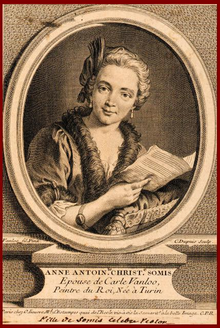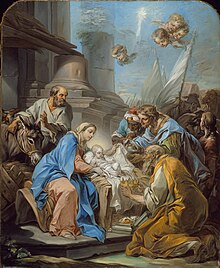Charles André van Loo
Charles André van Loo , called Carle van Loo or Carle Vanloo , (born February 15, 1705 in Nice , † July 15, 1765 in Paris ) was a French painter.
Life
He was the son of the painter Louis Abraham van Loo (1656–1712) and came from an originally Flemish family of artists: his grandfather Jacob van Loo (1614–1670) and his older brother (around 21 years old) Jean-Baptiste van Loo (1684– 1745) were also painters. Carle made a steep career in his day and was the most famous painter of the van Loo dynasty in the 17th and 18th centuries.
Since he lost his father at the age of 7, he was raised by his brother Jean-Baptiste in his family, whom he followed on two trips to Italy (1712-1715 and 1716-1718) to Turin and Rome . On the second of these trips he received drawing lessons from the painter Benedetto Luti and studied with the sculptor Pierre Legros . Various gallant and other adventures did not prevent him from successfully studying painting, but otherwise left him quite uneducated. He is also said to have been a pupil of Pierre Gobert , a court painter to Louis XIV .
In 1720 he went to Paris, where his first oil painting The Good Samaritan (1723) was created. He assisted his brother on several commissions, in particular the restoration of Francis I's gallery in the castle of Fontainebleau (1724). He received his first commission in 1725 with The Presentation of Jesus in the Temple for the chapter house of Saint-Martin-des-Champs. For Jakob cleans his house before leaving for Bethel , he received the Prix de Rome of the Academy in 1724 .
The prize was actually connected to a stay in Rome at the French academy there, but the academy withheld the money and so he had to earn the trip to Italy by drawing portraits and decorative paintings for the Paris Opera himself, so that he did not enter until May 1728 Rome arrived at the same time as his future rival François Boucher and his nephews Louis-Michel van Loo (1707–1771) and François van Loo (the sons of his brother Jean-Baptiste). In Italy he was known for his trompe-l'oeil painting of ceiling paintings of mythological and religious scenes (e.g. La Glorification de saint Isidore , 1729), which attracted the attention of Pope Benedict XIII. procured. His most important work at this time is Aeneas wearing Anchises (1729).
In 1732 he traveled to Turin via Florence , where he worked for King Charles Emmanuel III. of Sardinia Diana and her nymphs rest in the ceiling of the Queen's rooms in the Stupinigi Hunting Lodge and painted a series of oil paintings for the Palazzo Reale in Turin.
In 1733 he returned to Paris due to the War of the Polish Succession , where he arrived in 1734. There he was admitted to the Royal Academy of Art ( Académie royale de peinture et de sculpture ) in August 1734 and was a member in 1735, not least because of his painting Apollo Marsyas flies . His career was now making rapid progress. In 1737 he became a professor at the Académie and was commissioned with a series of mythological paintings (so-called supraports or dessus-de-porte , canvas paintings embedded in the wall paneling) of the princely living quarters of the Hôtel de Soubise . In 1747 he painted an allegorical composition Asia for the salon of the city apartment of Samuel-Jacques Bernard (1686–1753) in the Rue du Bac in Paris. At the same time he painted a number of religious paintings such as Saint Charles Borromeo Giving Communion to Lepers of 1743 for the Chapel of Saint-Marcel of the Cathedral of Notre Dame de Paris , The Adoration of the Angels (1751) for the Chapel of the Assumption of the Virgin of the Church of Saint -Sulpice or six panel paintings with scenes from the life of St. Augustine for the choir of the Petits-Pères church (1746–1755). He was also very fashionable for Parisian society with his portraits of people in Turkish robes, which were popular at the time.
Van Loo was supported by both the court and Madame de Pompadour . In 1736 he painted exotic hunting scenes for the gallery of the Petits Appartements du Roi in the Palace of Versailles ( bear hunt and ostrich hunt ), which Boucher also painted at the same time. In 1744 he painted scenes for the Dauphin's cabinet in Versailles. 1747–1748 he painted two large portraits of the king and queen. He also worked regularly for the Pompadour and painted in 1764: Les Arts implorant la Destinée d'épargner la vie de Md. De Pompadour (The arts implore fate to spare the life of Md.de Pompadour).
In April 1749 he became the first head of the École royale des élèves protégés . In 1754 he was elected rector and in June 1763 director of the academy. He was ennobled in 1750 and appointed Chevalier de l'ordre de Saint-Michel in 1751. In June 1762 he became Premier peintre du Roi (First Painter of the King). In 1764 he made a short trip to London and died a year later at the height of his fame. His most famous student was Jean-Honoré Fragonard . Further students were Jean-Baptiste Deshays (1729–1765), Boucher's son-in-law, François-Hubert Drouais (1727–1775), who were also students of Boucher, Louis Jean François Lagrenée (1724–1805), Nicolas-Bernard Lépicié (1735– 1784) and Johann Heinrich Tischbein the Elder (1722–1789).
He was married to the soprano Antonia Christina van Loo (1704–1785), sister of the Italian-French violinist and composer Giovanni Battista Somis . Both met in 1733 during his stay in Turin. The couple had four children who reached adulthood: Marie-Rosalie van Loo (1737–1762) and Jules César Denis van Loo (1749–1821), Jean François van Loo and Charles van Loo.
Major works
Carle van Loo worked for the court, the tapestry factory , the church and for wealthy private individuals in almost all genres: religious, historical, mythological and allegorical paintings, genre scenes (especially Turkish subjects). Friedrich Melchior Grimm considered him to be the first painter in Europe and Voltaire put him on a par with Raphael. At the end of the 18th century his star went out and the students of Jacques-Louis David invented the swear word "vanlotter".
Carle van Loo was a painter of masterful technique. In the “lighter” subjects he did not come close to his great rival Boucher in the popularity of his contemporaries, but his genre scenes such as the stop at the hunt in 1737 in the Louvre today provide an authentic picture of the courtly life of Louis XV. Of outstanding importance are the subtle drawings and paintings from his family life, some of which were intended for the public.
Mythological scenes and allegories
- Aeneas wears anchises , 1729, Paris, Louvre .
- Theuseus Tames the Bull by Marathon , circa 1730, Los Angeles , Los Angeles County Museum of Art.
- Bacchus and Ariadne , approx. 1732, private property
- Apollo and Marsyas , 1735, Paris, University of the Arts (École nationale supérieure des beaux-arts)
- Perseus and Andromeda , approx. 1735–1740, Saint Petersburg , Hermitage .
- Alexander's victory against Porus , 1738, Los Angeles , Los Angeles County Museum of Art.
- Interior decoration of the Hôtel de Soubise , Rue des Francs-Bourgeois, Paris:
- Mars and Vénus (in situ);
- Mercury gives axes to the loggers (in situ);
- Venus's Toilet (1738, in situ).
- L'Asie , ca.1747, Jerusalem , The Israel Museum
- The drunkenness of Silene , 1747, Nancy , Musée des Beaux-Arts de Nancy
- New interior decor of the Salle du Conseil in Fontainebleau 1751–1753:
- The war
- The earth
- The bravery (La Valeur) .
- Jupiter and Antiope , 1753, Saint Petersburg, Hermitage
- The Painting , The Music , The Architecture 1753, San Francisco , Art Museum
- Neptune and Amymone , around 1757, Nice, Musée Chéret (cardboard for wallpaper) and Paris, Musée du Louvre.
- The Three Graces , ca.1763, Los Angeles , Los Angeles County Museum of Art.
- The arts implore fate to spare the life of Md. De Pompadour , 1764, Pittsburgh , The Frick Art Museum
Genre scenes
- La Chasse à l'Ours (Bear Hunt) , 1736, Amiens , Musée de Picardie
- Halt de chasse (rest while hunting) , 1737, Paris, Musée du Louvre.
- Picnic in the Green after the Hunt , 1737, New York City , Metropolitan Museum of Art .
- The Pasha Has His Maitresse Paint , 1737, Richmond, Virginia Museum of Fine Arts.
- The Sultan gives a concert for his Maitresse , 1737, London, The Wallace Collection.
- Ostrich Hunt , 1738, Amiens, Musée de Picardie
- The Spanish Reading , 1754, Saint Petersburg, Hermitage
Religious painting
- The Good Samaritan , 1723, Montpellier , Fabre Museum
- Jacob cleans his house before leaving for Bethel , 1724,
- The Presentation of Christ in the Temple , 1725, Lyon , Saint-Jean Cathedral
- The Glorification of Saint Isidore , 1729, Rome , San Isidoro Church
- Saint Charles Borromeo gives communion to lepers , 1743, Paris, Notre-Dame
- The Sermon of St. Anthony, 1746–55 Oil on canvas, Notre-Dame-des-Victoires, Paris
- Adoration of the Angels , 1751, Brest , Musée des Beaux-Arts
- Conversion of Saint Hubert , 1758, Rambouillet , Saint-Lubin-et-Saint-Jean church.
- Adoration of the Magi , ca.1760, Los Angeles , Los Angeles County Museum of Art.
- Blue Virgin , 1765, Paris, Saint-Merry church .
- Martyrdom of Saint Étienne , Valenciennes, Musée des Beaux-Arts
Portraits
- Marie Leczinska, Queen of France (1703-1768) , 1747, Palace of Versailles
- Louis XV , 1748, Versailles Palace
- Louis XV , 1751, Versailles Palace
- Portrait of Jacques-Germain Soufflot (1714-1781) , Versailles Palace
- Portrait of the innocent Guillemette de Rosnyvinen de Pire , 1762, Rennes , Musée des Beaux-Arts
- Giovanni Battista Somis
- Lorenzo Somis
literature
- Colin B. Bailey (Ed.): Les Amours des dieux. La peinture mythologique de Watteau à David. Fort Worth et Paris, Kimbell Art Museum et Réunion des musées nationaux, 1991.
- Loo, Carle Van . In: Hans Vollmer (Hrsg.): General lexicon of fine artists from antiquity to the present . Founded by Ulrich Thieme and Felix Becker . tape 23 : Leitenstorfer – Mander . EA Seemann, Leipzig 1929, p. 361-362 .
- Pierre Rosenberg , Marie-Catherine Salut: Exhibition catalog. Nice 1977.
Web links
- Charles André van Loo in Google Arts & Culture
- Gettymuseum
- Carle Vanloo at www.artcyclopedia.com
- French biography
- Biography in historicum.net
Individual evidence
- ↑ Ulrike von Hase-Schmundt: Joseph Stieler 1781-1858. His life and his work. Critical list of works. Prestel, Munich 1971, ISBN 3-7913-0340-6 , p. 94.
- ↑ Christina Antonia Somis. Essai de Généalogie. In: gw.geneanet.org. Retrieved August 21, 2015 .
- ↑ Glenn Burdette (Ed.): Giovanni Battista Somis. Sonatas for violin and basso continuo: opus 3. A – R Editions, Inc., Wisconsin, 1998, ISBN 0-89579-422-5 , p. IX.
- ↑ Tillman Seebass (Ed.): Annuario Internazionale Di Iconografia Musicale. Duke University Press, 1984 ISBN 0-8223-0461-9 , p. 106.
- ^ The Wallace Collection: Treasure of the Month: January 2010. In: wallacecollection.org. Retrieved August 21, 2015 .
- ↑ According to other sources, she was born around 1710.
| personal data | |
|---|---|
| SURNAME | Loo, Charles André van |
| ALTERNATIVE NAMES | van Loo, Carle; Vanloo, Carle |
| BRIEF DESCRIPTION | French Rococo painter |
| DATE OF BIRTH | February 15, 1705 |
| PLACE OF BIRTH | Nice |
| DATE OF DEATH | July 15, 1765 |
| Place of death | Paris |





